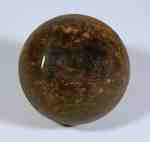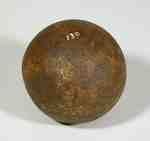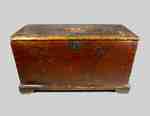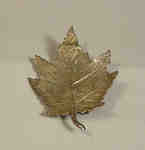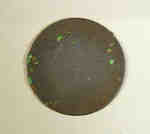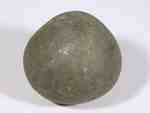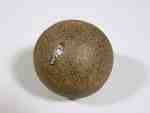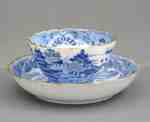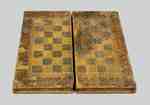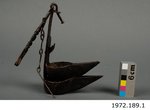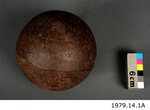Results
- A 12 pound cannon ball that is believed by some to have been one of the shots lobbed ashore by the schooners of the British Fleet during the Engagement of Forty Mile Creek, June 8, 1813. It may alsoA 12 pound cannon ball that is believed by some to have …
- A charm that was built into the fireplace of the Nelles Manor, home of Col. Robert Nelles. It was common for charms such as this to be built into fireplaces in the year 1800 or earlier with the belieA charm that was built into the fireplace of the Nelles Manor, …
- A 10 pound cannonball that is believed to have been used by either American or British forces. It was found near Nelles Blvd, in Grimsby, on land belonging to Col. Robert Nelles at the time of the WaA 10 pound cannonball that is believed to have been used by …
- Size: 35 inches long x 14.5 inches wide x 19 inches highSize: 35 inches long x 14.5 inches wide x 19 inches high
- This is a silver maple leaf pin from the Loyal Canadian Society. Every year, since its organization in 1847, this society held its Annual Dinner on the 13 of October; the anniversary of General BrockThis is a silver maple leaf pin from the Loyal Canadian Society. …
- This coin is from Upper Canada and is dated 1816. On one side the date is in the centre surrounded by the words: "SUCCESS TO COMMERCE & PEACE". On the other side there is an urn in the centre, toppedThis coin is from Upper Canada and is dated 1816. On one …
- A cannonball believed to be from the War of 1812.A cannonball believed to be from the War of 1812.
- A powder horn with brass fittings at both ends. There is one brass ring remaining to which some material such as hide or leather would have been fastened for carrying purposes. At the narrow end therA powder horn with brass fittings at both ends. There is one …
- A round solid iron cannonball, pitted. It is most likely from the Engagement at Forty Mile Creek on June 8, 1813.A round solid iron cannonball, pitted. It is most likely from the …
- A wooden shingle from the barn at Lake Lodge. It has four holes in the body and curves in the centre. There is writing on the end of one side that states: "Aug. 9, 1932, shingle from barn of Lake LodA wooden shingle from the barn at Lake Lodge. It has four …
- The origin of the sword is unknown and there are no distinct markings on it. It is believed however, that the sword would have been carried by the Light Cavalry (Light Dragoons and the Hussars). TheThe origin of the sword is unknown and there are no distinct …
- A commemorative ribbon celebrating 100 years of peace between Great Britain and the United States of America. The front has a metal piece with the years 1814 and 1914 and a "G" symbol on it with theA commemorative ribbon celebrating 100 years of peace between Great Britain and …
- A cup and saucer, dated c. 1790, with a blue willow pattern and a gold edge. This cup was made without a handle. The pair is also called a tea bowl and saucer. It is believed that this item was in usA cup and saucer, dated c. 1790, with a blue willow pattern …
- A chessboard made of tooled leather with a blackgammon board inside. When folded, the board is made to look like a book. On the side is printed "History of Asia" with additional decorative designs. PA chessboard made of tooled leather with a blackgammon board inside. When …
- Referred to "The Military Arms of Canada" by The Upper Canada Historical Arms Society and "The British Military Longarms 1715-1815' by D.W. Bailey.Referred to "The Military Arms of Canada" by The Upper Canada Historical …
- This Phoebe lamp is one of the earliest types of lamps that had been used in the colonies during the 17th century to early 19th century. The lamp consists of two small iron bowls with spouts, one hanThis Phoebe lamp is one of the earliest types of lamps that …
- This Land/India Pattern bayonet was produced by the British Government ca. 1730-1815. This type of bayonet was used during the War of 1812. With a 17 inch blade and flat top, the bayonet gradually naThis Land/India Pattern bayonet was produced by the British Government ca. 1730-1815. …
- Referred to in "Guns Through the Ages" by Geoffrey Boothroyd.Referred to in "Guns Through the Ages" by Geoffrey Boothroyd.
- A cannonball of this type would have been used during the War of 1812. This brown, iron cannonball is 16 inches in circumference and approximately 5 inches in diameter. The surface is of the cannonbaA cannonball of this type would have been used during the War …





